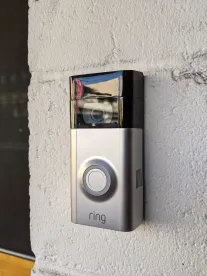While many consumers are aware of (and use) the Ring doorbell and security camera system to track who is at their front door, Ring now is offering a drone designed to capture video inside your house. The Ring Always Home Cam is an autonomous flying device (i.e., drone) with a built-in camera to record movement. As of today, this Always Home Cam is available for purchase by invitation only. You can visit Ring’s website and “Request an Invitation.” This in-home drone security system costs $250.
The idea behind the Always Home Cam is to alleviate the need to have multiple fixed cameras all around your house. Instead, you can just push a button and send the Always Home Cam drone flying around to surveil your home’s interior. If you don’t want it flying all day, you can program it to identify certain activities during a specific timeframe. For example, you can program it to only surveil at night while everyone is asleep or while you are away on vacation. The drone can stream video directly to your smartphone or tablet and video clips are stored in the cloud for 60 days (with a paid subscription).
What does this drone look like? Well, it’s lightweight with plastic-tipped propellers and sits on a docking station designed to block the camera when the drone is not in use. It also has an onboard neural processing unit that enables it to identify different scenarios as well as objects throughout your home. This drone technology can identify windows and determine how light shining through the window affects the video input (and how the drone deciphers it), mirrors, chandeliers, children, animals, and other objects throughout a home; there is no universal home blueprint. The question here is: how can we leverage this technology to assist in the integration of drones into our airspace? Or on public roads for autonomous vehicles? There is no doubt that Ring will continue to address some of these navigational challenges in the technology as it collects data from the ”invited” customers, but what are the privacy implications?
This new Always Home Cam as well as Ring’s traditional doorbell security system use end-to-end encryption for video capture, and those captured videos will not be part of Ring’s partnership with law enforcement. However, could this constant in-home surveillance actually make our homes less safe? This has been a debate among both civil liberties and digital rights advocates, with their concern being that there is potential for abuse of this data collection or the possibility that devices like this will capture video of individuals who have not consented to such video capture. One thing is clear: as we have entered a world in which digital surveillance – and now, even in-home surveillance – is becoming more and more commonplace (and now, in-home drone surveillance), we should keep privacy and security of the data on the forefront as a key component to the development and use of this technology.



 />i
/>i
